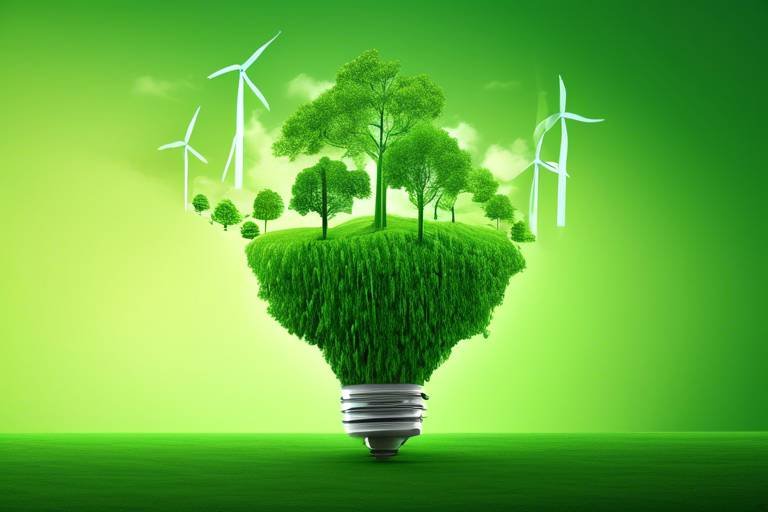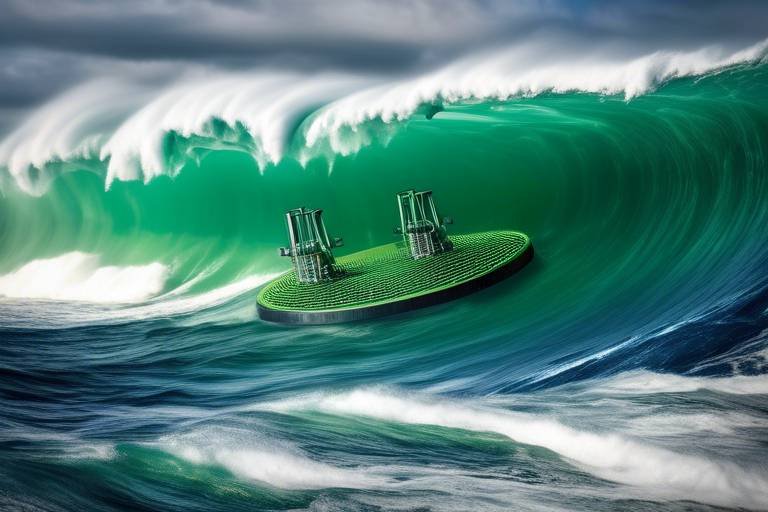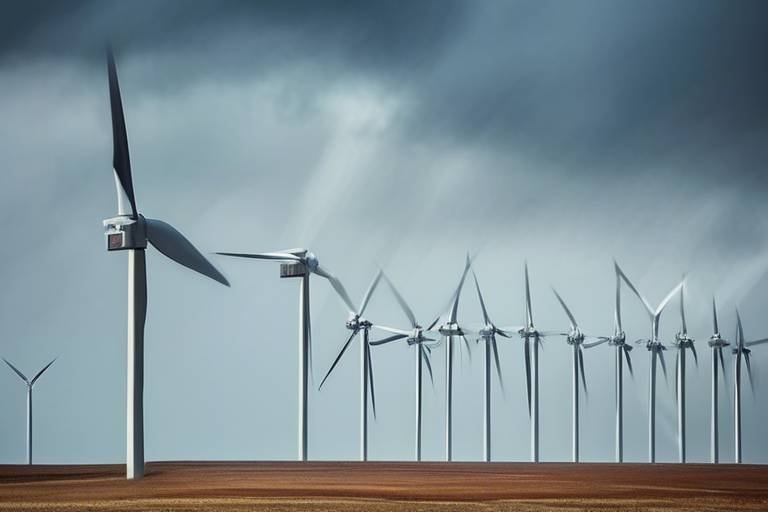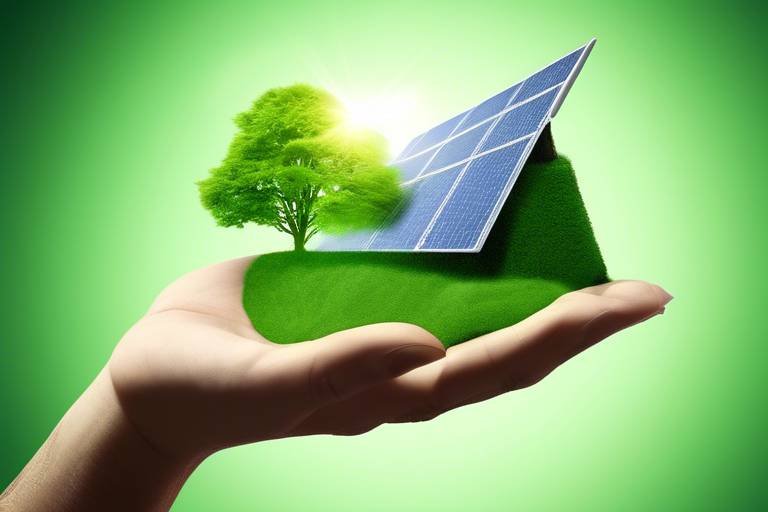Guidelines for Installing a Green Energy System at Home
This article provides essential guidelines for homeowners considering the installation of green energy systems. It covers various aspects, including types of systems, benefits, installation processes, and maintenance tips.
Green energy systems harness renewable resources to generate power. These systems are not just a trend; they are a vital step towards a sustainable future. Imagine waking up every day knowing that your energy is coming from the sun or the wind instead of depleting natural resources. There are several types of systems to consider:
- Solar Panels: These capture sunlight and convert it into electricity, making them one of the most popular choices for homeowners.
- Wind Turbines: If you live in a breezy area, wind turbines can be a fantastic way to harness wind energy.
- Geothermal Heating: This system taps into the earth's natural heat for efficient heating and cooling.
Each of these systems has unique features and benefits. For instance, solar panels are relatively easy to install and can significantly reduce your electricity bills. Wind turbines, on the other hand, can generate power even on cloudy days, while geothermal systems offer incredible efficiency in temperature regulation throughout the year.
Before diving into installation, it’s crucial to evaluate your home's energy consumption. Think of it like trying to find the right pair of shoes; you wouldn’t buy a size too big or too small, right? Similarly, determining the right size of your green energy system is essential. Consider factors like:
- Your household size
- The number and types of appliances you use
- Seasonal variations in energy consumption
By understanding these elements, you can make an informed decision about which green energy system will best meet your needs.
An energy audit is like a health check-up for your home’s energy use. It identifies inefficiencies and areas where you can save. To conduct a thorough audit, you can use various tools and techniques. Start by examining your energy bills; they can provide insights into your consumption patterns. Additionally, consider using energy monitoring devices that can track real-time usage.
Homeowners can choose between conducting a DIY energy audit or hiring a professional. A DIY audit can be cost-effective and empowering, allowing you to learn about your home. However, a professional audit often provides a more comprehensive analysis and can identify issues you might overlook. It’s essential to weigh the pros and cons:
| Option | Pros | Cons |
|---|---|---|
| DIY Audit | Cost-effective, educational | May miss critical issues |
| Professional Audit | Thorough, expert insights | Higher cost |
Understanding the results of your energy audit is crucial for effective planning. It’s like reading a map before a road trip; you need to know where you stand to decide where to go. Focus on the areas that require immediate attention and prioritize improvements that will maximize your energy efficiency. This could mean sealing drafts, upgrading insulation, or investing in energy-efficient appliances.
When selecting the most suitable green energy system, it’s essential to evaluate various factors. Think about your energy needs, budget, and local regulations. It’s like picking the right tool for a job; the right choice can make all the difference. Compare options carefully to ensure you make an informed decision that aligns with your lifestyle and financial situation.
Installing a green energy system requires careful planning and execution. It’s not just about slapping on some solar panels and calling it a day; there’s a process involved. Here’s a general overview of the steps:
- Obtaining necessary permits
- Choosing qualified installers
- Final system checks and inspections
Before installation, homeowners must navigate local regulations and obtain necessary permits. Understanding these legal aspects is crucial; it’s like following the rules of the road to ensure a smooth journey. Each locality has its own requirements, so be sure to research what’s needed in your area.
Choosing the right installer is vital for a successful green energy system installation. You wouldn’t trust just anyone to fix your car, right? The same goes for your energy system. Look for qualified professionals, ask questions about their experience, and check their credentials to ensure you’re making the right choice.
Q: How much can I save on my energy bills with a green energy system?
A: Savings vary based on system type, size, and local energy rates, but many homeowners see significant reductions.
Q: Do I need to maintain my green energy system?
A: Yes, regular maintenance is essential to ensure optimal performance and longevity.
Q: Can I install a green energy system myself?
A: While some systems can be DIY, most require professional installation to meet safety and efficiency standards.

Understanding Green Energy Systems
When we talk about green energy systems, we're diving into a world where power comes from nature, not fossil fuels. Imagine harnessing the sun's rays, the wind's whispers, or the earth's warmth to light up your home and power your appliances. It's not just a dream—it's a reality that's becoming increasingly accessible to homeowners everywhere. So, what exactly are these systems, and how do they work? Let’s break it down.
First up, we have solar panels. These sleek, rectangular devices capture sunlight and convert it into electricity. Think of them as tiny power plants sitting on your roof, soaking up the sun's energy during the day. They can significantly reduce your electricity bills and even allow you to sell excess power back to the grid! Plus, with advancements in technology, solar panels are becoming more efficient and affordable than ever.
Next, let's talk about wind turbines. If you've ever seen those giant, spinning blades on a hilltop, you've encountered a wind turbine. These systems harness the kinetic energy of the wind and transform it into electricity. While they require a bit more space than solar panels, they can be incredibly effective in areas with consistent wind flow. Imagine living in a breezy location and being able to generate your own power just by letting nature do its thing!
Then we have geothermal heating, which is like having a cozy blanket of warmth beneath your feet. This system utilizes the earth's natural heat to warm your home during the chilly months. By tapping into the stable temperatures below the surface, geothermal systems can provide efficient heating and cooling, making them a fantastic option for homeowners looking to reduce their carbon footprint.
Now that we've covered the main players in the green energy game, it’s essential to recognize the benefits they bring to the table. Not only do they help reduce your reliance on traditional energy sources, but they also contribute to a healthier planet by lowering greenhouse gas emissions. Plus, many green energy systems can increase your home’s value—who wouldn’t want a property that’s both eco-friendly and cost-efficient?
In summary, understanding green energy systems is about recognizing the potential of renewable resources. Whether you opt for solar panels, wind turbines, or geothermal heating, each system offers unique features and benefits that can transform your home into a sustainable haven. As we move forward in this article, we’ll explore how to assess your home’s energy needs and choose the right system for you. So, are you ready to take the plunge into the world of green energy?
- What is the most popular type of green energy system? Solar panels are often the most popular due to their versatility and decreasing costs.
- How much can I save on energy bills with these systems? Savings vary, but many homeowners see a significant reduction in their monthly energy costs.
- Are there government incentives for installing green energy systems? Yes, many regions offer tax credits, rebates, and other incentives to encourage green energy adoption.

Assessing Your Home's Energy Needs
Before diving headfirst into the world of green energy systems, it's absolutely essential to take a step back and evaluate your home's energy consumption. Think of this process as getting a health check-up for your house. Just as you wouldn’t rush into surgery without understanding your health condition, you shouldn’t install a green energy system without knowing your energy needs. So, how do you figure this out? Well, it’s easier than you might think!
Start by considering several key factors that influence your energy consumption. These include your household size, the number and type of appliances you use, and any seasonal variations in energy use. For instance, if you have a large family, your energy needs will naturally be higher than someone living alone. Similarly, if you rely heavily on electric heating during winter months, this will also impact your overall energy requirements.
To get a clearer picture, you might want to track your energy usage over a month or two. This can be done by checking your utility bills or using smart home devices that monitor energy consumption. You can create a simple table to visualize this data:
| Month | Energy Consumption (kWh) | Major Appliances Used |
|---|---|---|
| January | 850 | Heating, Refrigerator, Washer |
| February | 800 | Heating, Refrigerator, Dryer |
| March | 600 | Refrigerator, Air Conditioner |
Once you have a good understanding of your energy consumption patterns, you can determine the appropriate size and type of green energy system that will best suit your needs. This is where things get exciting! Imagine being able to harness the sun’s energy or the wind's power to not only reduce your carbon footprint but also save on those pesky utility bills.
But wait, there’s more! You should also consider how energy-efficient your home is. Factors such as insulation, windows, and the age of your appliances play a significant role in how much energy you consume. Conducting a quick energy audit can help identify areas where you can improve efficiency before you even think about installing a new system. This could mean sealing drafts, upgrading to energy-efficient appliances, or even investing in better insulation. Not only will these improvements lower your energy needs, but they can also make your home more comfortable!
In summary, assessing your home's energy needs is a crucial step in the journey towards installing a green energy system. By understanding your consumption patterns, considering your household size, and evaluating your home's efficiency, you can make informed decisions that will lead to a more sustainable and cost-effective energy solution. So, roll up your sleeves and get ready to take control of your energy future!
- How can I reduce my energy consumption before installing a green energy system? Start with simple changes, like switching to LED bulbs, unplugging devices when not in use, and improving insulation.
- What tools can I use to track my energy usage? Smart meters and energy monitoring apps can provide real-time data on your energy consumption.
- How often should I conduct an energy audit? It’s recommended to conduct an energy audit at least once a year or whenever you make significant changes to your home.

Conducting an Energy Audit
Conducting an energy audit is a critical step in maximizing your home's energy efficiency and ensuring that your green energy system is tailored to your specific needs. Think of it as a health check-up for your home; just as you would assess your physical well-being, your house requires a thorough evaluation to identify where energy is being wasted and how it can be optimized. An energy audit provides you with a detailed understanding of your current energy consumption, which can lead to significant savings in both energy costs and environmental impact.
To get started, you can either conduct a DIY energy audit or hire a professional. If you decide to go the DIY route, you’ll need to gather some essential tools: a notepad, a flashlight, and possibly a thermal imaging camera. These tools will help you identify areas where heat escapes, like drafty windows or poorly insulated walls. During your audit, pay attention to the following key areas:
- Insulation: Check your attic, walls, and floors for adequate insulation. Poor insulation can lead to significant heat loss.
- Windows and Doors: Inspect for drafts and ensure that seals are intact. Consider using weather stripping to reduce air leaks.
- Appliances: Evaluate the energy efficiency of your appliances. Older models tend to consume more energy.
- Lighting: Take note of your lighting fixtures. Switching to LED bulbs can drastically reduce energy consumption.
After gathering all the necessary information, it’s time to analyze your findings. This is where the real magic happens! You’ll want to look for patterns in your energy use, such as peak consumption times or areas where energy is wasted. For instance, if your heating bill spikes during winter, it may indicate insufficient insulation or outdated heating systems. By pinpointing these issues, you can prioritize which improvements to tackle first.
One effective method to interpret your audit results is to create a simple table that outlines your current energy consumption compared to your energy-saving goals. Here’s a sample layout:
| Area of Concern | Current Consumption (kWh) | Target Consumption (kWh) | Potential Savings (kWh) |
|---|---|---|---|
| Heating | 500 | 300 | 200 |
| Cooling | 400 | 250 | 150 |
| Lighting | 300 | 100 | 200 |
By analyzing this table, you can see where your biggest savings opportunities lie. It’s not just about cutting back; it’s about making smart investments in energy efficiency that will pay off in the long run. Remember, even small changes can lead to substantial savings over time. So, whether you decide to take the DIY approach or hire a professional, conducting an energy audit is a vital step in your journey towards a greener home.
In conclusion, conducting an energy audit gives you the insights needed to make informed decisions about your energy consumption. It’s like having a roadmap that guides you through the maze of energy efficiency. By taking the time to understand your energy use, you can not only save money but also contribute to a more sustainable future. So grab your tools, roll up your sleeves, and get auditing!
Q: What is an energy audit?
A: An energy audit is an assessment of your home’s energy use, identifying areas where energy is wasted and suggesting improvements for efficiency.
Q: Can I perform an energy audit myself?
A: Yes, you can conduct a DIY energy audit using basic tools and techniques. However, hiring a professional can provide a more comprehensive analysis.
Q: How often should I conduct an energy audit?
A: It’s recommended to conduct an energy audit every few years or whenever you make significant changes to your home or energy systems.
Q: What are the benefits of an energy audit?
A: Benefits include reduced energy bills, improved comfort, increased home value, and a smaller carbon footprint.

DIY vs. Professional Audits
When it comes to energy audits, homeowners often find themselves at a crossroads: should they tackle the task themselves or enlist the help of a professional? This decision is more than just a matter of convenience; it can significantly impact the effectiveness of your energy efficiency efforts. Let's break down the pros and cons of both approaches to help you make an informed choice.
Starting with DIY audits, this option appeals to many homeowners who are eager to save money and take a hands-on approach. By conducting a DIY audit, you can familiarize yourself with your home’s energy consumption patterns and identify areas for improvement. Additionally, there are numerous resources available online, including energy audit checklists and tools that can guide you through the process. However, it’s important to note that a DIY audit may lack the thoroughness and expertise that a professional can provide. Homeowners might overlook critical issues or make incorrect assumptions about their energy usage.
On the flip side, hiring a professional auditor brings a wealth of experience and knowledge to the table. Professionals use advanced tools and techniques to conduct a comprehensive analysis of your home's energy consumption. They can identify inefficiencies that you might not even be aware of and provide tailored recommendations for improvements. While the cost of a professional audit can be a downside, the long-term savings on energy bills and the potential for increased comfort in your home often outweigh the initial investment. However, it’s crucial to choose a qualified auditor to ensure you receive valuable insights.
To summarize, here are some key points to consider:
- DIY Audits:
- Cost-effective
- Empowers homeowners
- May lack thoroughness
- Professional Audits:
- Comprehensive analysis
- Expert recommendations
- Higher upfront cost
Ultimately, the choice between a DIY audit and a professional one depends on your comfort level with the process, your budget, and your specific energy goals. If you’re tech-savvy and enjoy DIY projects, starting with a DIY audit might be a great way to dip your toes in. However, if you want a thorough understanding of your home’s energy profile and are willing to invest a bit more, hiring a professional could be the way to go. Remember, the goal is to create a more energy-efficient home that saves you money and reduces your carbon footprint, regardless of the path you choose!
Q1: What tools do I need for a DIY energy audit?
A DIY energy audit can be conducted with basic tools such as a digital thermometer, a flashlight, and a notepad for taking notes. You might also want to use a thermal imaging camera if you have access to one, as it can help identify areas of heat loss.
Q2: How much does a professional energy audit cost?
The cost of a professional energy audit can vary widely depending on the size of your home and the complexity of the audit, typically ranging from $200 to $600. Some utility companies even offer rebates or discounts, so it's worth checking with them!
Q3: How often should I conduct an energy audit?
It’s a good practice to conduct an energy audit every few years or whenever you make significant changes to your home, such as renovations or adding new appliances. Regular audits can help you stay on top of your energy efficiency efforts.

Interpreting Audit Results
Once you've completed your energy audit, you may find yourself staring at a sea of numbers and graphs, wondering what it all means. Fear not! Interpreting audit results is like piecing together a puzzle; it requires a bit of patience and understanding, but ultimately reveals the bigger picture of your home's energy efficiency. The first step is to identify key metrics such as your total energy consumption, peak usage times, and areas where you may be losing energy. For instance, if your audit shows that a significant amount of energy is being used during specific hours, it might indicate that you need to adjust your usage habits or invest in energy-efficient appliances.
Next, focus on the areas highlighted in your audit report. These may include insulation levels, window efficiency, and the performance of your HVAC system. Each of these components plays a crucial role in your home’s overall energy efficiency. If your audit uncovers that your insulation is lacking, you might want to consider upgrading it to reduce heating and cooling costs. Likewise, if windows are marked as a significant source of energy loss, you could explore options like double-glazing or thermal curtains to improve their performance.
To make the most of your audit results, it can be helpful to create a prioritized action plan. This plan should focus on the improvements that will yield the most significant energy savings for the least amount of investment. For example, if your audit indicates that replacing old light bulbs with LED options would save you a substantial amount on your electricity bill, that should be at the top of your list. On the other hand, if your HVAC system is nearing the end of its life, it might be worth considering a replacement, even if it requires a larger upfront cost.
Additionally, keep in mind that some improvements may qualify for local incentives or rebates, which can significantly offset your costs. Always research available programs in your area and factor these potential savings into your decision-making process. A well-informed homeowner can make the most out of energy audits, turning data into actionable steps that lead to both energy savings and a more sustainable lifestyle.
Finally, don't hesitate to reach out to professionals if you're unsure about how to interpret specific results. Many energy audit companies offer follow-up consultations to help homeowners understand their data. Remember, the goal is to create a comfortable, energy-efficient home that not only saves you money but also contributes to a greener planet.
- What is an energy audit? An energy audit is an assessment that evaluates your home’s energy use and identifies areas for improvement.
- How often should I conduct an energy audit? It's recommended to conduct an energy audit every few years or when you make significant changes to your home.
- Can I perform an energy audit myself? Yes, you can conduct a DIY energy audit, but hiring a professional can provide a more comprehensive analysis.
- What improvements can I make after an energy audit? Common improvements include upgrading insulation, sealing leaks, and replacing old appliances with energy-efficient models.

Choosing the Right Green Energy System
When it comes to selecting the right green energy system for your home, it can feel a bit like wandering through a maze—exciting yet overwhelming. With numerous options available, each with its own set of advantages and disadvantages, making the right choice is crucial. The first step is to consider your specific energy needs. Are you looking to power your entire home, or just a few appliances? Understanding your consumption patterns will help you narrow down your options and avoid overspending on a system that exceeds your requirements.
Next, think about your budget. While some systems, like solar panels, have a higher upfront cost, they often lead to significant savings in the long run. On the other hand, smaller systems may be more affordable initially but could result in higher energy bills over time. It's essential to weigh the initial investment against potential savings. Additionally, explore any available incentives or rebates in your area, as these can significantly reduce the overall cost of installation.
Another critical factor to consider is the local regulations and incentives. Different regions have varying policies regarding renewable energy systems, which can impact your installation process. For example, some areas may require specific permits, while others might offer tax credits or rebates for homeowners who invest in renewable energy. Researching these regulations beforehand will save you time and hassle down the road.
To help you visualize your options, here’s a brief comparison of popular green energy systems:
| System Type | Pros | Cons |
|---|---|---|
| Solar Panels |
|
|
| Wind Turbines |
|
|
| Geothermal Heating |
|
|
Finally, don't forget to consider the space available for installation. Some systems, like solar panels, require ample roof space, while others, such as geothermal systems, need room for underground loops. Assessing your property will help you determine which options are feasible.
In conclusion, choosing the right green energy system is a multifaceted decision that requires careful consideration of your energy needs, budget, local regulations, and available space. By taking the time to evaluate these factors, you'll be well on your way to making an informed choice that aligns with your goals for sustainability and energy independence.
Q: How do I know which green energy system is best for my home?
A: Start by assessing your energy consumption, budget, and available space. Research the different systems, and consider consulting with a professional for personalized advice.
Q: Are there government incentives for installing green energy systems?
A: Yes, many regions offer tax credits, rebates, and other incentives to encourage homeowners to invest in renewable energy. Be sure to check local regulations.
Q: How long does it take to install a green energy system?
A: The installation time varies depending on the system type. Solar panel installations typically take a few days, while geothermal systems may take longer due to the complexity of the installation.

Installation Process Overview
Installing a green energy system at home is an exciting venture that not only contributes to a sustainable future but also helps you save on energy costs. However, before you dive in headfirst, it’s essential to understand the installation process thoroughly. This process typically involves several key steps, each of which plays a vital role in ensuring that your system operates efficiently and effectively. From initial planning to the final installation checks, each phase requires careful consideration and execution.
The first step in the installation process is planning. This involves determining the type of green energy system that best suits your needs, whether it be solar panels, wind turbines, or geothermal heating. Each system has its own unique requirements and benefits, so taking the time to research your options can save you a lot of headaches later on. Additionally, you’ll want to consider the orientation of your home, local weather patterns, and any potential obstructions that could hinder energy production.
Once you’ve selected the appropriate system, the next phase is permitting. Before any installation work can begin, you must navigate through local regulations and obtain the necessary permits. This can sometimes feel like wading through molasses, as each municipality has its own set of rules. However, obtaining these permits is crucial for ensuring that your installation complies with local building codes and safety standards. It’s a good idea to check with your local government or a professional installer to understand the specific permits required in your area.
The actual installation process typically begins with the pre-installation assessment. During this phase, a qualified installer will visit your home to evaluate the site and confirm that everything is in order for installation. This includes checking the structural integrity of your roof (for solar panels), the layout of your property (for wind turbines), and the accessibility of the installation site. This step is crucial because it ensures that there are no unexpected surprises during the installation.
After the assessment, it’s time for the installation itself. This is where the magic happens! Depending on the type of system you’ve chosen, the installation process can vary significantly. For solar panels, the installer will mount the panels on your roof and connect them to an inverter that converts the sunlight into usable electricity. For wind turbines, the process may involve erecting a tower and ensuring that it is securely anchored. Regardless of the system, it’s vital to have qualified professionals handle the installation to ensure safety and efficiency.
Once the installation is complete, the next step is to conduct a final inspection. This is where your installer will check the entire system to ensure everything is functioning correctly and safely. They will verify that all connections are secure, that the system is producing energy as expected, and that it meets all safety regulations. This is a crucial step; think of it as the final quality check before you start reaping the benefits of your new green energy system.
Finally, after everything is up and running, you’ll want to consider the maintenance aspect of your green energy system. Regular maintenance is essential to keep your system operating at peak efficiency. This may include periodic checks, cleaning solar panels, or ensuring that wind turbines are free from debris. By staying proactive with maintenance, you can extend the lifespan of your system and maximize your energy savings.
In summary, the installation process for a green energy system is a multi-step journey that requires careful planning, adherence to regulations, and professional expertise. By understanding each phase of the process, you can ensure a smooth installation and enjoy the benefits of renewable energy for years to come.
- What is the average cost of installing a green energy system? The cost can vary widely depending on the type of system and the size of your home. Typically, solar panel installations can range from $15,000 to $30,000 before incentives.
- How long does the installation process take? Installation can take anywhere from a few days to several weeks, depending on the complexity of the system and the permitting process.
- Do I need to be home during the installation? It is not necessary to be home for the entire installation, but it’s a good idea to be available for any questions or decisions that may arise.
- What happens if my system produces more energy than I use? Many regions offer net metering, allowing you to sell excess energy back to the grid, which can offset your energy costs even further.

Permitting and Regulations
When it comes to installing a green energy system in your home, navigating the world of can feel like trying to find your way through a dense forest without a map. But fear not! Understanding these legal requirements is essential to ensure your installation is compliant and hassle-free. The first step is to research local regulations, as these can vary significantly depending on your location. Some areas may offer incentives for renewable energy installations, while others might have strict zoning laws that you must adhere to.
Typically, you will need to obtain a building permit before installation. This process often involves submitting detailed plans of your intended system, including specifications about the equipment you plan to use. For instance, if you're installing solar panels, you may need to provide information about the type of panels, their placement, and how they will connect to your home’s electrical system. It's a bit like preparing for a big presentation; the more thorough your documentation, the smoother the approval process will be.
In addition to local permits, you might also need to consider state and federal regulations. For example, if you’re planning to install a wind turbine, there may be specific guidelines regarding its height and distance from property lines. Moreover, some states require an environmental review to assess the impact of your system on local wildlife and ecosystems. This step is crucial for ensuring that your green energy project is not only beneficial for you but also for the community and environment.
To help you understand the permitting landscape better, here’s a quick overview of common permits you might encounter:
| Type of Permit | Description |
|---|---|
| Building Permit | Required for structural changes, such as installing solar panels on your roof. |
| Electrical Permit | Necessary for any electrical work related to your green energy system. |
| Zoning Permit | Ensures that your installation complies with local zoning laws. |
| Environmental Permit | May be required for systems that could impact local wildlife or ecosystems. |
Before diving into the installation process, it’s wise to consult with local authorities or a professional installer who understands the regulatory landscape. They can provide valuable insights and help you navigate the often-complex permitting process. Remember, skipping this step can lead to costly fines or even having to dismantle your system, which is the last thing you want after putting in all that effort!
In summary, while the permitting and regulatory requirements may seem daunting, they are a necessary part of the journey toward harnessing green energy for your home. By doing your homework and ensuring compliance, you not only protect your investment but also contribute to a more sustainable future.
- What permits do I need to install solar panels?
You will typically need a building permit and possibly an electrical permit, depending on your local regulations. - How long does it take to get permits?
The timeframe can vary, but it generally takes anywhere from a few days to several weeks, depending on your locality. - Can I install a green energy system without permits?
No, it is crucial to obtain the necessary permits to avoid fines and ensure your system is safe and compliant. - Do I need a professional to help with permitting?
While it's possible to navigate the process yourself, consulting a professional can save you time and ensure all requirements are met.

Finding Qualified Installers
When it comes to installing a green energy system in your home, finding the right installer is absolutely crucial. After all, this is an investment not just in your property, but in a sustainable future! A qualified installer can make all the difference in ensuring your system operates efficiently and effectively. But how do you go about finding these professionals? Let’s dive into some essential tips that will help you in your search.
First and foremost, start by doing some research. You can look online for local companies that specialize in green energy installations, such as solar panel, wind turbine, or geothermal heating systems. Websites like EnergySage or SolarReviews can provide valuable insights and reviews from other homeowners. Don't overlook the power of word-of-mouth recommendations from friends and family who have already made the leap into green energy. Their experiences can guide you toward reliable installers.
Once you have a list of potential installers, the next step is to vet them thoroughly. Here are some key questions to ask during your initial conversations:
- What certifications do you have? - Look for installers who are certified by recognized organizations, such as the North American Board of Certified Energy Practitioners (NABCEP) for solar, or similar bodies for wind and geothermal systems.
- Can you provide references? - A reputable installer should have no problem providing you with references from past clients. Reach out to these clients to ask about their experiences.
- What warranties do you offer? - Understanding the warranties on both the equipment and the installation work is vital. This will give you peace of mind about your investment.
Another important aspect to consider is the installer’s experience with your specific type of green energy system. Each system has its nuances, and an installer who specializes in solar panels may not have the same expertise with wind turbines. It's beneficial to find someone who has a proven track record with the type of system you're interested in.
Additionally, ensure that the installer is familiar with local regulations and permitting processes. This knowledge can save you a lot of headaches down the road, as they can help you navigate the necessary paperwork and ensure that your installation complies with local laws. A qualified installer will also be up-to-date with any incentives or rebates available in your area, which can significantly reduce your overall costs.
Finally, don’t forget to get multiple quotes before making your decision. This not only gives you a sense of the market rate but also allows you to compare the services offered by different installers. Remember, the cheapest option isn’t always the best. Look for a balance between cost and quality of service. Once you’ve gathered enough information, you’ll be well-equipped to make an informed choice.
In conclusion, finding a qualified installer for your green energy system is a process that requires careful consideration and research. By asking the right questions, checking credentials, and comparing options, you can ensure that your installation is handled by a professional who will help you reap the maximum benefits from your investment. After all, a successful installation is the first step toward a greener, more sustainable home!
- How do I know if I need a professional installer? - If you're unfamiliar with electrical or mechanical systems, it's best to hire a professional to ensure safety and compliance with regulations.
- What should I look for in an installer? - Look for certifications, experience with your specific system, references, and knowledge of local regulations.
- Can I install a green energy system myself? - While DIY installations are possible, they often require a high level of expertise and may not qualify for certain rebates or incentives.
Frequently Asked Questions
- What types of green energy systems are available for home installation?
There are several types of green energy systems you can consider for your home, including solar panels, wind turbines, and geothermal heating. Each system harnesses renewable resources in unique ways, offering different benefits like reduced energy bills and lower carbon footprints.
- How do I assess my home's energy needs before installation?
To assess your home's energy needs, start by evaluating your current energy consumption. Consider factors such as the size of your household, the number of appliances, and seasonal variations in energy use. This information will help you determine the appropriate size and type of green energy system for your home.
- What is an energy audit, and how can I conduct one?
An energy audit is an assessment that identifies inefficiencies in your home’s energy use. You can conduct a DIY audit by checking for drafts, evaluating your insulation, and reviewing your energy bills. Alternatively, you can hire a professional auditor who will use specialized tools to provide a comprehensive analysis.
- Should I choose a DIY energy audit or hire a professional?
Choosing between a DIY energy audit and hiring a professional depends on your comfort level and expertise. A DIY audit can save you money but may not uncover all inefficiencies. On the other hand, a professional audit can provide a thorough assessment but comes with a cost. Weigh the pros and cons based on your situation.
- How do I interpret the results of my energy audit?
Interpreting your energy audit results involves identifying areas where you can improve efficiency. Look for recommendations on insulation, appliance upgrades, and energy usage patterns. Prioritize the improvements that will yield the most significant energy savings and consider implementing them gradually.
- What factors should I consider when choosing a green energy system?
When selecting a green energy system, consider your energy needs, budget, available space, and local regulations. Research different systems to find one that aligns with your goals and circumstances. It's also wise to consult with professionals who can provide insights tailored to your situation.
- What steps are involved in the installation process of a green energy system?
The installation process typically involves several key steps: obtaining permits, preparing your site, installing the system, and conducting final checks. Each step requires careful planning to ensure everything is compliant with local regulations and functions correctly.
- How do I find qualified installers for my green energy system?
To find qualified installers, start by asking for recommendations from friends or family. Check online reviews and certifications, and don’t hesitate to interview potential installers. Ask about their experience, warranties, and any relevant credentials to ensure you’re making an informed choice.



















